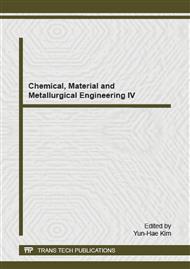p.57
p.61
p.68
p.72
p.76
p.82
p.86
p.91
p.96
Gold Catalysts on TiO2-Modified Silica Gel for the Selective Cyclopentane Oxidation to Cyclopentanone
Abstract:
Amorphous silica gel was modified by titania via an impregnation-surface hydrolysis approach and used as the support for preparing gold catalysts through an direct anion exchange method. These supported gold catalysts were characterized by XRD and TEM, and applied for the catalytic cyclopentane oxidation to cyclopentanone using oxygen in the absence of any solvent and initiator. The catalyst with a loading of 0.1wt.% gold and 10wt.% TiO2 exhibited 7.2% cyclopentane conversion and 77.4% selectivities (including cyclopentanone and cyclopentanol) under the reaction conditions of 145°C, 2.0 MPa and 3 h. All the gold catalysts studied are very active in selective cyclopentane oxidation, and their high activities can be attributed to well dispersion and nanometer effect of gold particles within the catalysts.
Info:
Periodical:
Pages:
76-81
Citation:
Online since:
March 2015
Authors:
Keywords:
Price:
Сopyright:
© 2015 Trans Tech Publications Ltd. All Rights Reserved
Share:
Citation:


